Identity, biology and bionomics of the Common Mime Chilasa clytia Linnaeus (Lepidoptera: Papilionidae)
V.S. Revathy 1 & George Mathew 2
1,2 Kerala Forest Research Institute (Recognised Research Centre of University of Calicut), Peechi P.O., Thrissur District, Kerala 680653, India
1 revathybiju143@gmail.com (corresponding author), 2 mathew@kfri.org
doi: http://dx.doi.org/10.11609/JoTT.o3808.6719-22 | ZooBank: urn:lsid:zoobank.org:pub:0C9FF9EC-F486-415F-9DB9-A6E52595863B
Editor: Anonymity requested. Date of publication: 26 December 2014 (online & print)
Manuscript details: Ms # o3808 | Received 10 October 2013 | Final received 28 November 2014 | Finally accepted 02 December 2014
Citation: Revathy, V.S. & G. Mathew (2014). Identity, biology and bionomics of the Common Mime Chilasa clytia Linnaeus (Lepidoptera: Papilionidae). Journal of Threatened Taxa 6(14): 6719–6722; http://dx.doi.org/10.11609/JoTT.o3808.6719-22
Copyright: © Revathy & Mathew 2014. Creative Commons Attribution 4.0 International License. JoTT allows unrestricted use of this article in any medium, reproduction and distribution by providing adequate credit to the authors and the source of publication.
Funding: Kerala State Council For Science Technology And Environment (KSCSTE).
Competing Interest: The authors declare no competing interests.
Acknowledgements: The study formed a part of the PhD work of the first author and the financial assistance received from the Kerala State Council for Science Technology and Environment is greatly acknowledged.

The Genus Chilasa belonging to the tribe Papilionini was erected by Moore (1903) in his book entitled ‘Lepidoptera Indica’. Species belonging to this genus are mimics of the subfamily Danainae and hence, they are popularly known as mimes. The tribe Papilionini is classified into two genera Papilio and Chilasa based mainly on the pattern of oblique bands in the larva. The genus Chilasa comprises four groups, of which only two the agestor group and clytia group are found in the Indian region.
Chilasa clytia, a tailless swallowtail butterfly, was first described by Linnaeus in Systema Naturae (1758). Talbot (1939) reported it from Kerala. Its form commixtus is a protected species under Schedule I of Indian Wildlife Protection Act (1972) (GOI). It occurs in two different forms clytia and dissimilis in Kerala. The form clytia mimics the Common Crow Euploea core Cramer, while the form dissimilis mimics the Blue Tiger Tirumala limniace Cramer. The larva develops mostly on Cinnamomum sp. and severe outbreaks have been reported on Cinnamon Cinnamomum zeylanicum and Chinese Cassia Cinnamomum cassia with the larvae voraciously feeding on the tender and partly mature leaves, leaving only the midrib and veins. Both seedlings and saplings are affected by the heavy incidence of this butterfly has been reported to adversely affect the plant growth (Anandaraj & Devasahayam 2004; Rajapakse et al. 2007).
Identification of this species is based mainly on the descriptions given by Linnaeus (1758) and Talbot (1939). Considering its economic and ecological significance, a study was recently undertaken on the biology, ecology and taxonomy of this species and the results are presented here.
Materials and Methods
The sampling of butterflies was done by conducting a field survey in representative habitats in Kerala from 2010 to 2012. The areas covered included Nilambur (Malappuram District), Peechi, Vazhani (Thrissur District), Athirappilly, Vazhachal (Ernakulam District) and Thenmala (Kollam District). Several samples have been collected from the various locations. Six males and six females were used for genitalia studies. Morphological studies were made by making microscopic slide mounts of the genitalia. For preparing slide mounts of the external genitalia, the lower part of the abdomen (from the 7th segment onwards) was removed using micro-needles and treated with 10% KOH by gently boiling in a water bath. After appropriate maceration in KOH, the boiling was stopped and the material was thoroughly washed. The external genitalia were then extracted from the abdomen by gently tearing the inter-segmental membranes from and around the organ by using fine forceps and micro needles. After careful cleaning, the genitalia was stained with acid fuschin dissolved in acetic acid and transferred to carbol-xylol for clearing (Carbolic acid and xylol 2:3) and mounted in Canada balsam (Mathew & Menon 1985).
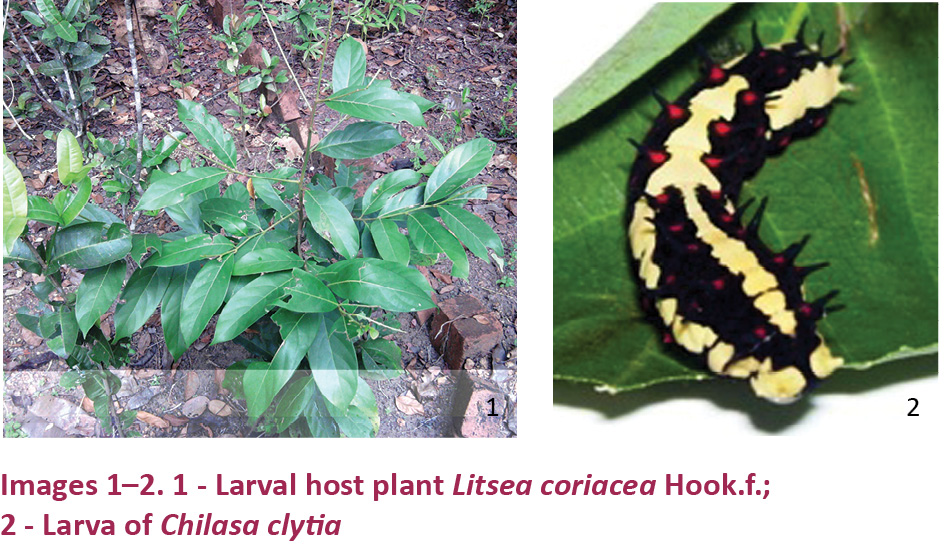
For studying its biology, eggs were collected from the field and reared in small glass jars, 16x10 cm in size, covered with a clean, dry cloth securely fastened with a rubber band. The containers were kept moist by placing a small piece of absorbent tissue holding as much water as will evaporate in 24 hours. All frass and excreta were removed daily and the larvae were provided with fresh leaves of the preferred host plant (Images 1,2). The duration of the larval instars was recorded based on observations of the moulted shells of the caterpillar’s head that remains inside the container after moulting. The size of the caterpillar (length and breadth), mode of feeding, pupation and emergence were also recorded.
On attaining the final instar, the container was provided with a dry twig placed diagonally within the container for giving anchorage to the developing pupa.
Results and Discussion
Genus: Chilasa Moore.
Chilasa Moore, 1881. Lepidoptera Ceylon, Moore, 1881. Lepidoptera Ceylon 1: 190pp.
Chilasa clytia Linnaeus (Common Mime)
Linnaeus, 1758. Syst. Nat. X: 479.
D’Abrera, 1982, Butterflies of the Oriental Region, Part 1: 92.
Wynter-Blyth, 1957. Butterflies of the Indian Region, Bombay nat. Hist. Soc., p. 381.
Material on collection: 2 exs., 13.i.x.2011. Peechi.
Distribution: Nepal, Bhutan, Sri Lanka, Myanmar, Bangladesh, Thailand, Southern China, Hongkong, Vietnam, Laos, Kampuchea, Malaysia, Philippines, Indonesia and India. In India it has been reported from Himachal Pradesh to Arunachal Pradesh, Sikkim, Assam, Bombay, Madhya Pradesh and southern India. It is well distributed all over the Western Ghats and has been recorded from many places in Kerala.
Descriptions: Chilasa clytia Linnaeus is a black-bodied swallowtail butterfly with a wing span of 79.3 (±11.16) mm. It serves as an excellent example of a Batesian mimicry among the Indian butterflies. Adults of dissimilis form have slow and graceful flight resembling that of the distasteful Blue Tiger and the adults of clytia form resemble the Common Crow. They have the habit of puddling on wet grounds.
Adults: The form clytia (mimics the Common Crow Euploea core). It has a velvety black forewing and hindwings with white spots and patches present on both sides of both wings. On the underside of the hindwing a row of brownish-yellow conical or angular marginal spots are present.
Male genitalia: Uncus is short, narrow, tubular, ending bluntly. Socii absent. Gnathos relatively small, lobed. Tegumen elongate, with narrow arms. Vinculum elongate with narrow arms. Valvae symmetrical, conical, flap-shaped. Cucullus is pointed, costal margin almost straight, with short dense setae along the distal margin. Harpe flat with two lobes. Saccular margin is slightly wavy on sides and slightly curved in the middle into which fits the juxta. Saccus is low and U-shaped (Fig 1). Phallus medium sized, tubular, curved in the middle and moderately thickened and apically blunt.
Female genitalia: Ovipositor bean-shaped, sclerotised and fringed with thin hairs. Posterior apophysis is long and curved. Anterior apophysis is short and apically swollen. Ostium wide, W-‘shaped, having lobular, leaf-like lobes at the base. Ductus bursa is short. Corpus bursae large, swollen and basally narrowed. Signum is long and spindle-shaped (Fig. 3).
Adults: The form dissimilis (mimics the Blue Tiger Danaus limniace). It is velvety-black with extensive white streaks and spots on the upperside. Underside is similar to the upperside with slightly larger white markings, and on the hindwing there is a row of conspicuous yellow marginal spots. In both forms head, thorax and abdomen are black with prominent white spots.
Male genitalia: Uncus short, swollen and ending bluntly. Socii absent. Gnathos lobed. Tegumen with narrow, elongated arms. Vinculum with narrow arms. Valvae ovate flap-like, fringed with short stiff setae. Cucullus blunt, costal margin almost straight, with a fringe of short setae. Harpe broad bearing pointed lobes, well sclerotised structure. Saccular margin curved and rounded. Saccus is low, broadly U-shaped. Phallus medium-sized, curved in the middle, apically broadened with uneven tip (Fig 2).
Female genitalia: Ovipositor lobes round in outline, fine setosed and sclerotised. Anterior apophysis about ½ the length of posterior apophysis. Ductus bursae small, short with uniform width. Corpus bursae more or less globular, with spindle-shaped signum (Fig. 4).
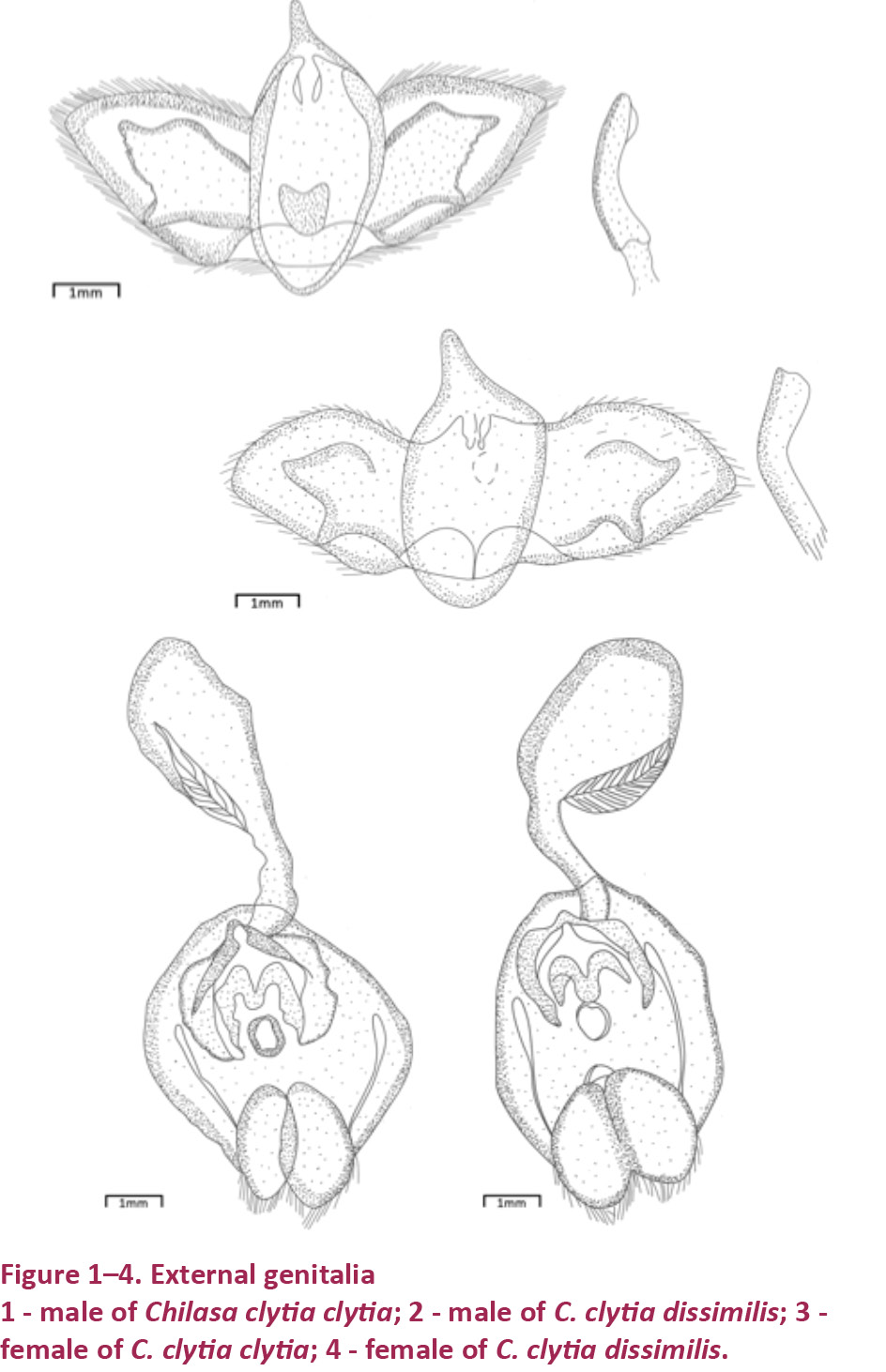
Biology of Chilasa clytia
Chilasa clytia Linnaeus is oligophagous (host plants belonging to one family), with the immature forms feeding on the leaves of the plants such as Cinnamomum zeylanicum, C. camphora, C. macrocarpum, Litsea chinensis, L. deccanensis, Persea macrantha and Alseodaphne semecarpifolia (Kehimkar, 2008). Recently, it was also found to feed on the leaves of Litsea coriacea (Lauraceae) growing on the campus of Kerala Forest Research Institute, subcentre, at Nilambur. In the latter host plant, six to eight eggs were found to be laid on the lower surfaces of tender leaves.
The egg is small, smooth, spherical, pale yellow in colour and 2.4–2.6 mm (2.6±0.03 mm) in diameter. The mean incubation period was 4.6 (±0.52) days and the larva has five instars. The 1st instar larvae, measured 3.9 (±0.7) mm in length and 0.1mm in width. The body colour of larvae is light brownish black with dirty white bands present on the last and first abdominal segments. Primary setae were present on the head. The last two abdominal segments had a row of tubercles on each side.
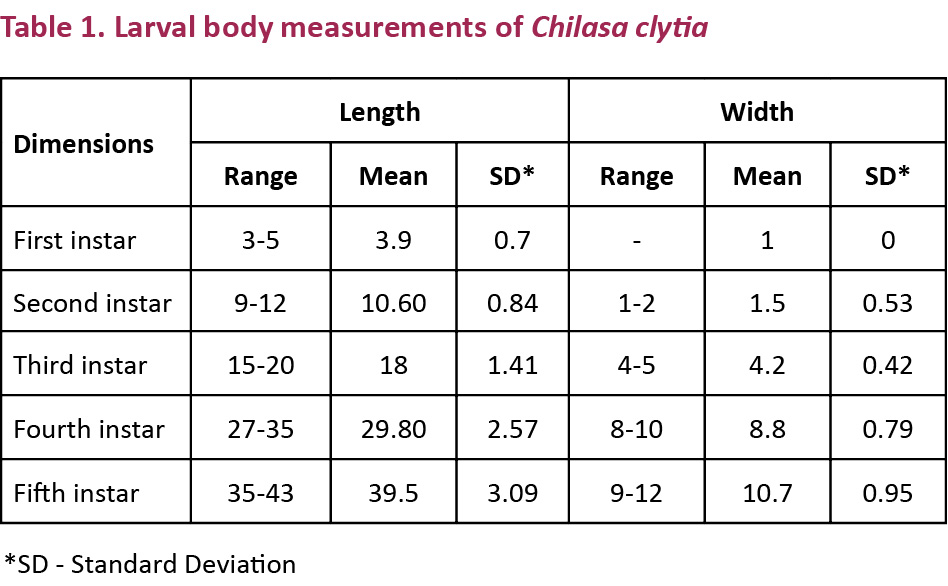
The 2 nd instar larvae were 10.60 (±0.84) mm in length and 1.5 (±0.53) mm in width and the 3rd instar larvae were 18 (±1.41) mm in lengths and 4.2 (±0.42) mm in widths. After the third moult, the larvae attained 29.80 (±2.57) mm in lengths and 8.8 (±0.79) mm in width. Larvae fed voraciously and attained 39.5 (±3.09) mm in length and 10.7 (±0.95) mm in width (Table 1, Image 2). The body was pure green in colour with two bands on head region. One band was present in between the eyes and other on the first thoracic segment. Two arch-shaped wide bands were present on the middle part of the abdominal segment. Whitish, spongy, broad stripes were present on the legs and prologs, running throughout the body. All instars possess an osmetarium, which is concealed. In the final instar, the osmetarium is indigo blue in colour. The pupal stage lasted for 13 to 17 days (Table 2).
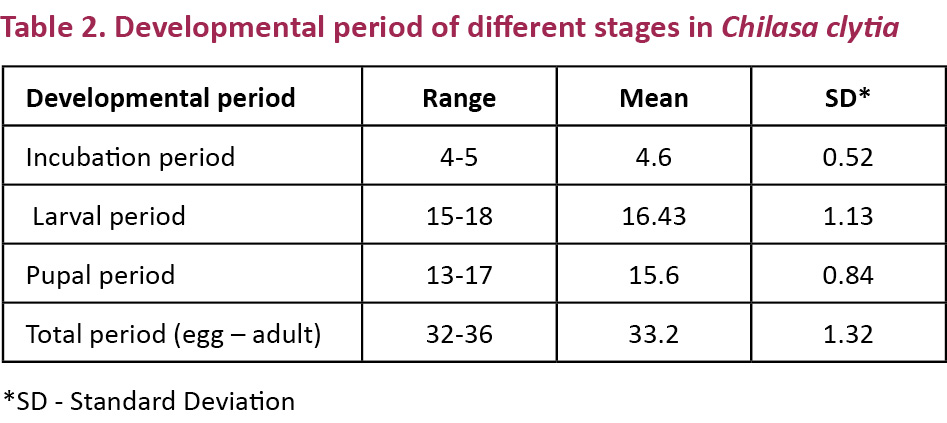
Ecology: Chilasa clytia Linnaeus is found in diverse habitats ranging from woody plains to moist deciduous patches. It is more abundant during the monsoon and post monsoon seasons. During this study it was observed that the form clytia was more abundant and common than the form dissimilis. Both forms were abundant during the monsoon and post monsoon seasons and they were least abundant during the summer season. The average sighting of the form clytia was 93 and that of the form dissimilis was 42 at Peechi during 2012, giving a ratio of 2:1. Therefore, it is presumed that the dissimilis form is relatively rarer compared to the form clytia. Both sexes feed on the flowers of a variety of plants including Lantana camara, Ixora sp. Clerodendrum capitatum, Cassia sp. Based on their sightings during surveys, their flight activity is maximum between 9:00–14:00 hr. During this study, it was observed that a sudden decline in number was attributed to parasitism of larval and pupal stages. The tachinid flies (Diptera: Tachinidae) showed a significant level of parasitism with the juvenile forms of C. clytia clytia.
Host plants: Cinnamomum zeylanicum, C. camphora, C. macrocarpum, Litsea chinensis, L. deccanensis, Litsea coriacea, Persea macrantha and Alseodaphne semecarpifolia.
Conclusions
On account of the occurrence of the different form which mimics Danainae butterflies, species identification of the Chilasa clytia L. is slightly confusing. An examination of the external genitalia revealed that both forms share close resemblance except for difference in the shape of valvae, harpe and phallus of male genitalia and the bursa copulatrix of the female genitalia. Direct or indirect effects of temperature have been observed in choice of oviposition sites, egg-laying rates, larval development and survival rates, and range shifts and expansions (Davies et al. 2005). A thorough knowledge of the life history of each species is a prerequisite to frame a comprehensive conservation strategy. Information generated on the biology and ecology of the Chilasa clytia L. will be useful in order to develop appropriate conservation strategies.
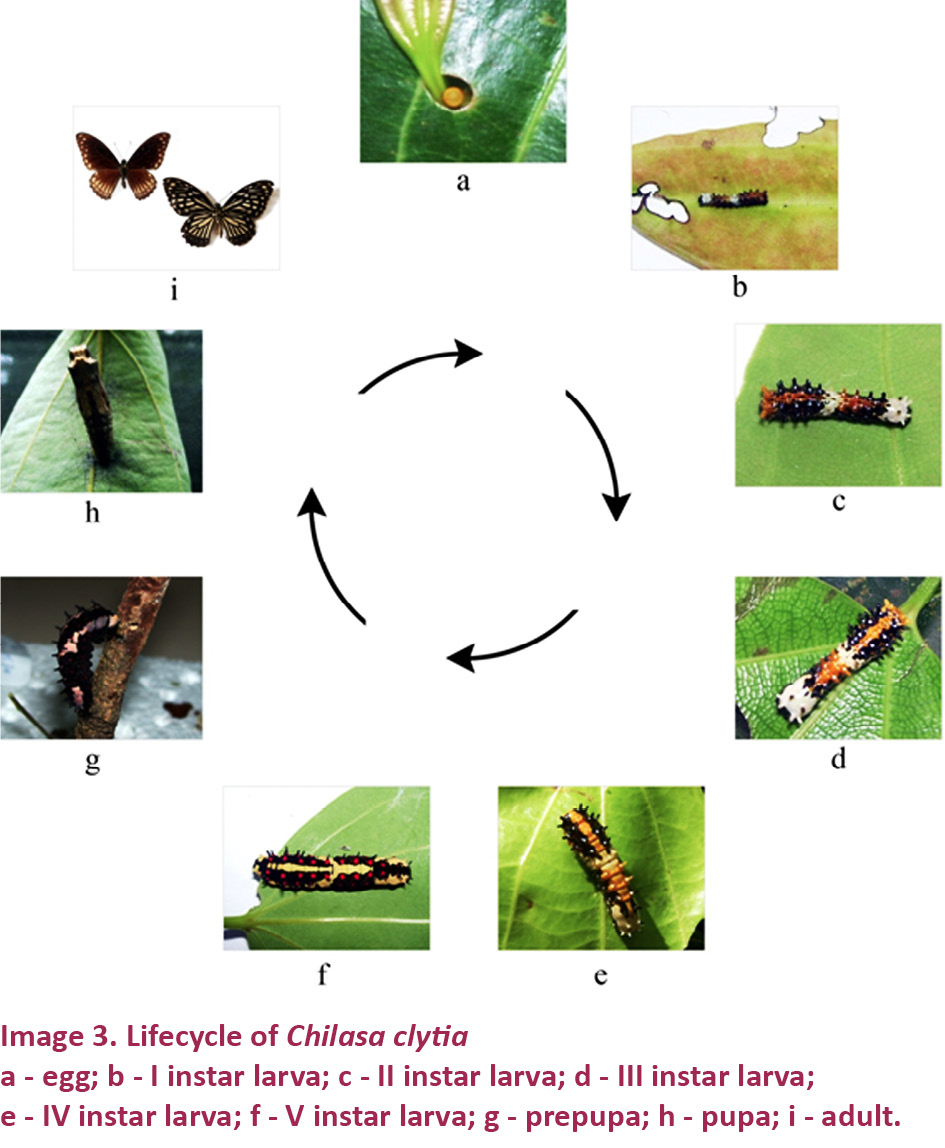
References
Anandaraj, M. & S. Devasahayam (2004). Pests and diseases of Cinnamon and Cassia, pp. 239–258. In Ravindran, P.N., K.N. Babu & M. Shylaja (eds.). Cinnamon and Cassia. CRC press, New York.
D’Abrera, B. (1982). Butterflies of the Oriental Region. Part I. Papilionidae, Pieridae and Danaidae. Hill House, in association with E.W. Classey, 244pp.
Davies, M.B., R.H. Shaw & J.R. Etterson (2005). Evolutionary responses to climate change. Ecology 86(7): 1704–1714.
GOI (1972). The Wildlife (protection) Act, (Amendment, 1982), Controller of Publication, Govt of India, New Delhi.
Kehimkar, I. (2008). The Book of Indian Butterflies. Bombay Natural History Society, 497pp.
Linnaeus, C. (1758). Systema Naturae per regna tria naturae, secundum classes, ordines genera, species, cum characteribus, differentiis, synonymis, locis (10th Ed.). Holmiae, 534pp.
Mathew, G. & M.G.R. Menon (1985). External genitalia of some Indian Pyralids (Lepidoptera). Journal of Entomological Research 9(1): 26–35.
Moore, F. (1881b). The Lepidoptera of Ceylon - 1. London, 190pp+ 171pls.
Rajapakse, R.H.S. & W.K.L. Kumara (2007). A review of identification and management of pests and diseases of Cinnamon (Cinnamomum zeylanicum Blume). Tropical Agricultural Research and Extension 10: 1–10.
Talbot, G. (1939). The Fauna of British India Including Ceylon, Burma. Butterflies, 1. Taylor & Francis Ltd., London, 1: xxix+600 pp., 184 text figs., 2 pls., 1 map.
Wynter-Blyth, M.A. (1957). Butterflies of the Indian Region. Bombay Natural History Society, 523pp.